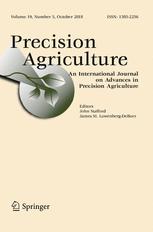Ver ítem
- xmlui.general.dspace_homeCentros Regionales y EEAsCentro Regional La Pampa - San LuisEEA AnguilArtículos científicosxmlui.ArtifactBrowser.ItemViewer.trail
- Inicio
- Centros Regionales y EEAs
- Centro Regional La Pampa - San Luis
- EEA Anguil
- Artículos científicos
- Ver ítem
Spectral indices from aerial images and their relationship with properties of a corn crop
Resumen
Identification of areas with similar restrictions to crop productivity could improve the efficiency to manage agricultural systems, guarantee stable yields, and reduce the effect of droughts in rainfed systems. The ability of any vegetation index to discriminate N and moisture-related changes in leaf reflectance would present an important advantage over the present diagnostic system which involves soil-testing for moisture and available N. The purpose of
[ver mas...]
Identification of areas with similar restrictions to crop productivity could improve the efficiency to manage agricultural systems, guarantee stable yields, and reduce the effect of droughts in rainfed systems. The ability of any vegetation index to discriminate N and moisture-related changes in leaf reflectance would present an important advantage over the present diagnostic system which involves soil-testing for moisture and available N. The purpose of the study was to calibrate different vegetation indices regarding their capacity to identify water and nitrogen availability for rainfed corn crops in the semiarid Pampas of Argentina. A field experiment with corn with a control without fertilization (N0), and fertilized with 120 kg ha−1 of nitrogen (N120) was used. Two sites, Low (L) and High (H), were identified within the field, according to their altimetry, a multi-spectral aerial photography was taken from a manned airplane during flowering stage of the corn crop, and four spectral indices were calculated (NDVI, green NDVI, NGRDI, (NIR/GREEN)-1). At six georeferenced points at each site soil texture, organic matter, available phosphorus, nitrogen and moisture contents as well as corn aerial biomass and grain yield were determined. The two sites differed in most of the evaluated soil properties, crop biomass and grain yield. The spectral information obtained at crop flowering showed clear differences between sites H and L for all four indices, indicating that any of these would be able to detect the differences in soil moisture and fertility among these environments. Both (NIR/GREEN)-1 and green NDVI had the best correlation with crop yield determined in the field, and therefore could be considered most appropriate for estimating corn yields from images taken at flowering. For estimation of N requirements, green NDVI differentiated best between fertilized and non-fertilized crop in the moisture limited environment (H), while (NIR/GREEN)-1 performed better in the site where soil moisture was non-limiting (L).
[Cerrar]

Autor
Farrell, Mauricio Aníbal;
Gili, Adriana Anahí;
Noellemeyer, Elke;
Fuente
Precision agriculture : 1–11. (28 March 2018)
Fecha
2018-03
Editorial
Springer
ISSN
1385-2256
1573-1618 (Online)
1573-1618 (Online)
Formato
pdf
Tipo de documento
artículo
Palabras Claves
Derechos de acceso
Restringido
 Excepto donde se diga explicitamente, este item se publica bajo la siguiente descripción: Creative Commons Attribution-NonCommercial-ShareAlike 2.5 Unported (CC BY-NC-SA 2.5)
Excepto donde se diga explicitamente, este item se publica bajo la siguiente descripción: Creative Commons Attribution-NonCommercial-ShareAlike 2.5 Unported (CC BY-NC-SA 2.5)

